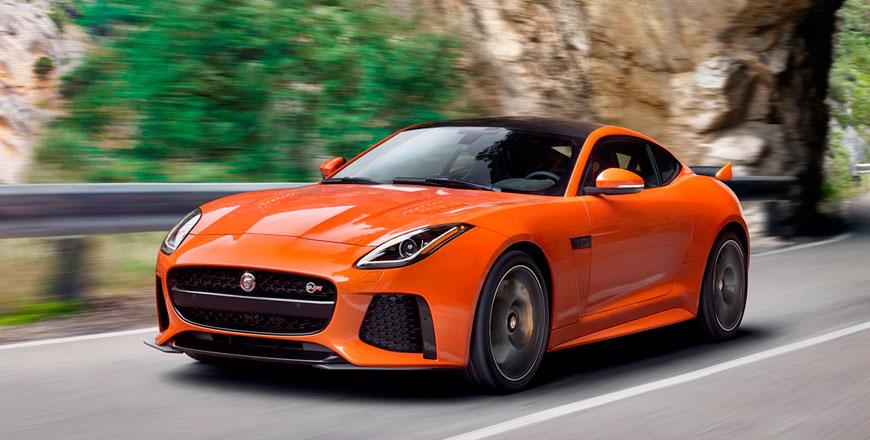You are here
Jaguar F-Type SVR: Fast and ferocious
By Ghaith Madadha - Feb 27,2017 - Last updated at Feb 27,2017

Photo courtesy of Jaguar Land Rover
Jaguar’s fastest road car bar the short-lived 1992-94 XJ220 supercar, the F-Type SVR is the full-fat version of the British brand’s now familiar Porsche 911-fighting sports car. Developed by Jaguar’s newly formed Special Vehicles Operations skunkworks division — and first capable of 200mph (322km/h) since the XJ220 — the F-Type SVR’s 2016 arrival comes three years after the first F-Type model hit showrooms.
A classic front-engine rear-drive brute in character, the SVR however employs standard rear-biased all-wheel-drive (AWD) to help manage its huge power and torque output. In essence, it is a more intense development of V8 engine versions of the standard model, rather than a revolution or revelation.
Assertive aesthetic
A curvy and sveltely feline design in standard guise, the F-Type’s design is beefed up somewhat for SVR service. Seemingly little altered from front views, the F-Type SVR’s broad hungry honeycomb grille, wrapover headlights and gaping side intakes are complemented with a sharper lower spoiler lip, while its long bonnet receives twin heat extraction vents. Swooping and sexy from front view, the F-Type’s angled bumper shut-line above the wheel-arch stands out slightly, but detracts little from its aesthetic.
Its body colour roof outline and dark panoramic roof panel accentuate the F-Type’s graceful lines, while wider 265/35ZR20 front and 305/30ZR20 rear tyres generate more grip necessary for the SVR’s increased power.
Designed with improved airflow in mind, the F-Type SVR features numerous tweaks, from its bumper, body vents and underbody covers to reduce lift and drag, while increasing downforce. Its most obvious aero enhancements are however its large rear venturi air splitter and dramatic active rear tailgate wing mounted above its moody slim rear lights.
But their overt aesthetics do alter the standard F-Type’s elegant design flow, and also seem to draw attention to, accentuate and visually add weight to the F-Type’s somewhat high and wide rear haunches. Underneath, the F-Type is built on a lightweight aluminium frame, and for SVR service features several revised weight-saving components, making it between 25-50kg lighter than the nearest AWD F-Type R version.
Bellowing brute
Gloriously thundering, bellowing and growling, the F-Type SVR’s supercharged 5-litre direct injection engine is familiar in lesser states of tune from many Jaguar Land Rover vehicles, but is tuned to produce an additional 25BHP and 14lb/ft here. Developing 567BHP at 6,500rpm and 516lb/ft throughout a sledgehammer-like 3,500-5,000rpm mid-range, the SVR is highly responsive from idling and throughout the rev range, owing to its mechanically-driven supercharger and ever-ready boost.
Leaping off-the-line with an instantaneous alacrity, the SVR rockets through 0-100km/h in 3.7 seconds and tops out at 322km/h. Relative to its size, output and hefty 1,705kg weight, the SVR’s 11.3l/100km combined cycle fuel consumption is moderate, but driven more spiritedly, becomes quite thirsty.
Building power and torque with a brutally progressive fashion, the SVR’s mighty supercharged V8 is nevertheless abundant throughout and allows for effortlessly brisk overtaking and indefatigably confident and quick progress on steep inclines.
Meanwhile, power is channelled through a slick, quick and smooth shifting 8-speed automatic gearbox, which can be operated through steering-mounted paddle shifters for more involvement, and can be set to for a more responsive shift mode through the infotainment screen, which also allows one to mix and match a choice of more ‘dynamic’ aggressive engine, suspension and steering settings.
Additionally, a more vocal exhaust note can be called up with the press of a button.
Balanced and intuitive
Instant in responses and fulsome in delivery, yet balanced and intuitive, the SVR’s character is that of a front-engine rear-drive sports car crossed with muscle car. Fitted with a rear-biased all-wheel-drive system and electronically controlled limited-slip rear differential to more effectively deploy its huge torque and power within a relatively small footprint, the SVR will instinctively initiate a power-slide when exiting a tight corner with too much throttle too early.
However, its rear differential actively distributes power to the rear wheel best able to but down to tarmac, while power is also subtly transmitted to the front axle to pull the SVR onto the straight and narrow.
More of a well-sorted brute rather than a scalpel-like Lotus Evora or a tenaciously gripping Nissan GT-R, the SVR’s rear-drive biased instincts lend it intuitive, if somewhat tail-happy handling traits. Meanwhile, with revised dampers, stiffer toe and camber settings, and torque vectoring automatically braking the inside wheel into corners, the SVR turns in with tidy precision and agility.
Meanwhile, its meaty and quick steering delivers good off-centre precision and responsiveness. Reassuring and talented through winding hill climbs, the SVR is also stable and settled at high speed and over imperfections, with buttoned down rebound control. Riding on the firm side, the SVR’s adaptive dampers provide taut cornering body control, especially when set to “dynamic” mode.
Luxuriously sporty
More forgiving and supple in “normal” mode for daily driving, the SVR drives with a high level of refinement for noise, vibration and harshness, while its huge brakes are reassuringly effective and fade-resilient. With its hunkered down driving position, thick steering wheel and peering over its long sculpted bonnet, the SVR’s driving position is easily accessible, alert, well-adjustable and adequately cosy.
Supportive and comfortable, its seat headrests are however unfortunately not adjustable and seem to bulge from the base of a taller driver’s neck upwards. Front and side visibility is good. However, rear and over-shoulder visibility is somewhat restricted owing to a small glasshouse, heavily sloped roofline, thick rear pillars and high-set and wide haunches.
Well crafted with quilted leather seats and upholstery with contrast stitching, soft textures, metals and suede aplenty and quality materials used throughout, the F-Type is luxurious and unmistakably sporty inside. Its cabin is driver-oriented and features user-friendly, intuitive controls, as well as an infotainment system with remote vehicle monitoring, remote start and climate control, using smartphone connectivity.
Convenience, safety and infotainment equipment levels are extensive. However, and on a more minor note, one does question the necessity of the additional weight of an electric operated opening tailgate hatch system as a standard feature in such a sports car for which Jaguar has otherwise been keen to apply weight-saving measures.
TECHNICAL SPECIFICATIONS
Engine: 5-litre, supercharged, in-line V8-cylinders
Bore x stroke: 92.5 x 93mm
Compression ratio: 9.5:1
Valve-train: 32-valve, DOHC, variable timing, direct injection
Gearbox: 8-speed automatic
Driveline: Four-wheel-drive, electronically-controlled limited-slip differential
Ratios: 1st 4.714; 2nd 3.143; 3rd 2.106; 4th 1.285; 5th 1.0; 6th 1.0; 7th 0.839; 8th 0.667
Reverse/final drive ratios: 3.317/2.56
Power, BHP (PS) [kW]: 567 (575) [423] @6,500rpm
Specific power: 113.4BHP/litre
Power-to-weight: 332.5BHP/tonne
Torque, lb/ft (Nm): 516 (700) @3,500-5,000rpm
Specific torque: 140Nm/litre
Torque-to-weight: 410Nm/tonne
0-100km/h: 3.7 seconds
Top speed: 322km/h
Fuel economy, combined: 11.3 litres/100km
CO2 emissions, combined: 269g/km
Fuel capacity: 70 litres
Track, F/R: 1,585/1,612mm
Suspension, F/R: Double wishbones, adaptive dampers
Steering: Electric-assisted rack & pinion
Brakes, F/R: 380/376mm ventilated discs
Brake callipers, F/R: 2-/1-piston
Tyres, F/R: 265/35ZR20/305/30ZR20















